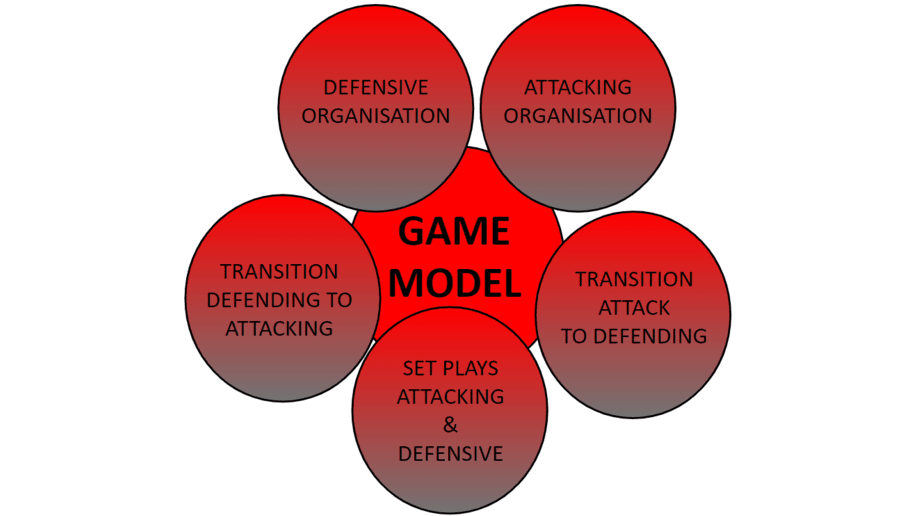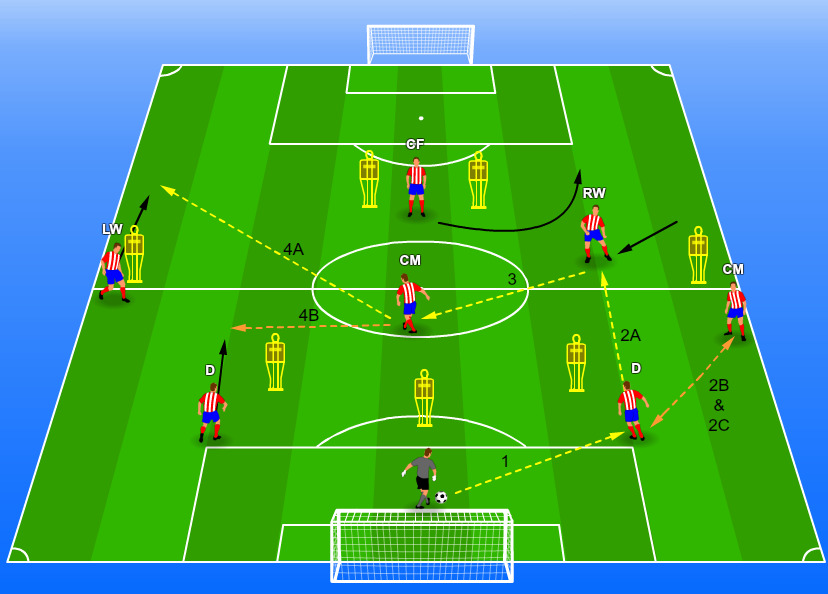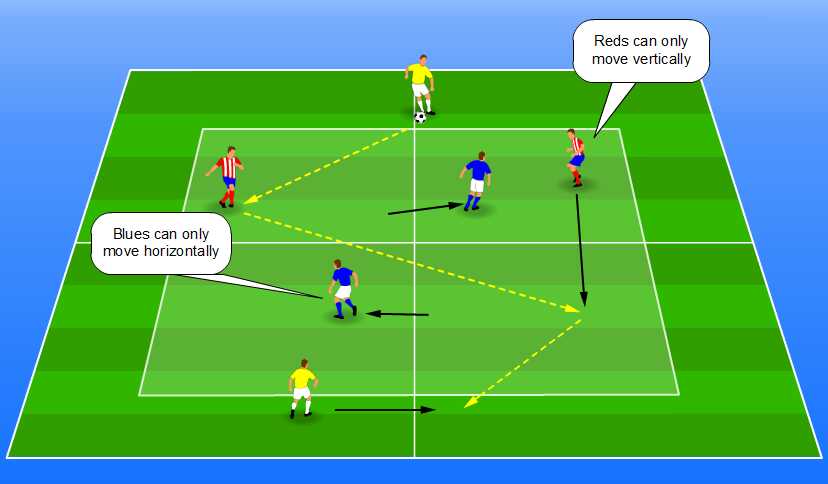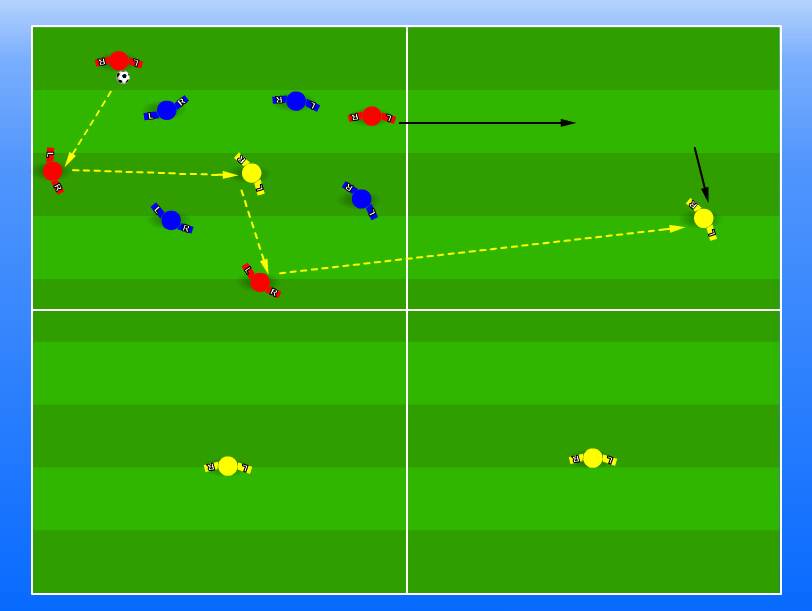Coaching a football team to play out from the back can be difficult.

Many patterns of play and training drills can help teams play out from the back, but it can be difficult to know which ones to use.
This blog post offers advice with a variety of training drills and patterns of play to help coaches coach their team to play out from the back.
After coaching many teams for well over a decade, I have applied many methods to create a team that feels confident about playing from the back.
For the past few years, I have been working with the Under 12’s who play 8-a-side football and I am going to share with you everything you need to know on how to coach a team to play confidently, starting with the goalkeeper.
These general themes will help any coach to train their team to play out from the goalkeeper:
- Introduce the topic of playing out from the back
- Discuss the benefits of playing out from the back
- Discuss the negatives of playing out from the back
- How to coach a team to play out from the back
- Training drills to help teams play out from the back
So let me help you go through these in more detail so that you are ready to apply these principles with your team.
Introduce the topic of playing out from the back

So the first thing we need to do is explain to the players what playing from the back means to our team.
In essence, we are trying to get the ball high up the field to create a goalscoring opportunity with the majority of players being involved in the build-up.
Young players may have questions about the pros and cons of building play from the back, so the next thing we need to do is to discuss the benefits of our team adopting this style of play.
Discuss the benefits of playing out from the back
Playing out from the back can be an extremely beneficial tactic, as it allows a team to retain possession of the ball, and build attacks from deep within their half, thus granting the majority of players a chance to get involved.
By playing out from the back, a team can control the tempo of the game and frustrate their opponents by keeping them pinned back.
Discuss the negatives of playing out from the back
It is also a good idea to discuss any negative points from playing from the back. after all, there are potential risks involved, for example, losing the ball due to:
- A bad pass
- A bad control
- Losing possession near the goal and conceding a goal.
Especially for young players, it is important for them to understand these potential dangers as they will probably happen several times throughout the season.
This is part of a young player’s development.
However, if the team know the risks and understand that the coach excepts the potential dangers then they can play without fear.
How to coach a team to play out from the back
Before you can implement anything on the training pitch, you must have a clear idea of how you want your team to play.
This is something that should not be made up as you go, during the training session, as the players will see very quickly that you have not thought about this in any great detail and this will lead to mixed messages.
That’s not to say you can’t keep notes with you for your training sessions to help guide you.
Create an identity
So before you begin the season, you ought to create the team’s identity.
Now, this is a phrase that you have probably heard a lot of on television, but if you are unsure of what it actually means then let me quickly explain…
In a nutshell, a team’s identity is the playing philosophy or game model which includes the five phases of play.

Communicate with your players, explain the plan and what is expected from each player in order for it to be successful
Creating patterns of play
Now that you have a clear picture in your head of what your team looks like when playing, you can start to create various patterns of play.
You ought to develop a number of plays, without overloading the players with too many ideas, in which players have options to adapt, depending on the positioning of the opposition.
An example of this can be seen in the image below.

These patterns of play should be practised regularly, without opposition players, so that the player’s synchronised movements become automatic.
Communicate with your players, explain the plan and what is expected from each player in order for it to be successful
Make sure to study them so that you understand them clearly… If you can’t remember the patterns of play, how do you expect the players to remember?
Training drills to help teams play out from the back
So let me disclose a few training drills that aim to improve the distinct elements of playing from the back…
Rondos
Rondos are great for tons of reasons, which you can see read in more detail in this article about rondos.
So here is one example of a rondo that mirrors playing out from the goalkeeper:

Synchronised movement
This training drill is to progress the player’s ability to react to a teammate’s movement and positioning to find an appropriate space to receive a pass.
Description:
Reds attempt to keep possession of the ball with the objective of transferring the ball from one yellow player to the other.
Rules:
- Reds can only move in a vertical direction
- Blues can only move in an horizontal direction
- Only a red player can pass to a yellow (not yellow to yellow)

Possession game
Possession games are superb for improving all the individual and team aspects of playing out from the back.
- Control and passing technique
- Maintaining possession
- Creating space
- Finding passing lanes
Description:
In this example, there is a 4v4+1, however, the number can easily be adapted to 6v6+2 or any other depending on how many players you have.
Teams play possession football inside one of the four squares, utilising the extra player to make X number of passes. Once the pre-determined number of passes has been completed, the ball can be transferred to any of the other three squares that also includes 1 extra player. When this happens the players, all the players (except the free player) rush to that square, where the game continues.

Three-quarter pitch – Playing out from the back
This is where the team can really apply those passing routines that you have created.
Simply set up the team with the goalkeeper starting the play and their objective is to simply cross the line with the ball
Begin without any opposition, practise the passing sequences and movement, and as the team progresses, it is a good idea to start introducing opposition players that will, in the beginning, put pressure on the ball passively and then actually fully commit to stealing the ball.
With the opposition players added, this will provoke the players to do a number of things in order to beat the press, such as:
- Independent thinking to find a solution to beat the opposition’s press
- Communication through the team to organise a play
Round-up
Coaches looking to help their team play out from the back can use the training drills and patterns of play provided in this article to get started.
It is important to create an identity for your team and develop patterns of play that players can easily understand.
As the team progresses, introduce opposition players into training exercises to better prepare the squad for competitive match situations.
Thank you for reading! Be sure to check out other blog posts for more great content.
